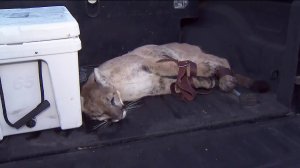Two young male mountain lions have been added to the National Park Service’s study of big cats in and around the Santa Monica Mountains, including one that made headlines when he was captured in Simi Valley late last week.
The Santa Monica Mountains National Recreation Area made the announcement on Tuesday afternoon in a somewhat cheeky Facebook post that began, “I saw two cougars and it almost made my puma pants.”
Taking a more serious tone, the post continued that one of the big cats, a subadult male dubbed P-78, was caught and collared in the central portion of the range last Wednesday.
The following morning, another puma — now known as P-79 — was spotted in the backyard of a residence in Simi Valley. The sighting occurred near the area where a female mountain lion attacked two dogs, killing one, the previous week, officials said.

California Department of Fish and Wildlife wardens were dispatched to the scene and tranquilized P-79.
He was outfitted with a GPS collar and released into the nearby Santa Susana Mountains.
The two new additions bring the total of mountain lions who have been monitored in the 17-year study to 79, including a total of five captured this year.
By tracking the big cats over a long period of time, researchers have discovered that mountain lions are virtually “trapped on an island of habitat,” according to Ana Beatriz Cholo, a spokeswoman for the recreational area.
Hemmed in by the freeways and the Pacific Ocean, the big cats face myriad challenges in the long-term survival of the species in the Los Angeles landscape, officials say.
Roads represent one major issue, with vehicle collisions among the leading causes of death.
Another threat is the presence of rat poisons, which have caused several mountain lion deaths.
The fragmented territory has also resulted in inbreeding, and the local population has among the lowest genetic diversity ever documented, according to the park service.
Los Angeles is just one of only two megacities in the world with a population of big cats living in city limits.
“The fact that the city can support such large-ranging animals is a testament to the quality of open space and the habitat connectivity that still remains,” according to NPS’s website.





















